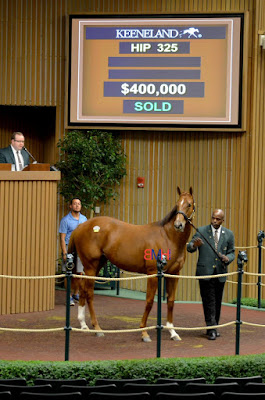Looking at How 2-Year-Old Champions Do As Older Horses
 | |
| 2009 2-year-old champion Lookin At Lucky was retired at the end of 2010 |
Due to the financial risk of a colt not coming back the same
or moving forward as an older horse (especially in the case of injury) a lot of
them are whisked off to stud before we get to see them past their classic season.
This leaves a lot of 'what ifs' left behind, especially if a horse was running near the top
of his game at the time of retirement or injury.
For the purpose of my research I looked at 2-year-old
champions from 1994-2013 of both sexes from the United States and Europe. While parts of the findings weren’t surprising, the
European 2-year-old filly champion stats definitely threw me off a bit.
U.S. 2-year-old champion males
The only horse on this table still racing is Shared Belief, who is a gelding and won the Grade 1 Santa Anita Handicap before getting hurt earlier this year. Shared Belief is currently preparing for his return to racing with a 5-year-old campaign in the cards. Overall, only four others have returned to the track after their 3-year-old seasons with Midshipman winning a conditions race in Dubai, Declan's Moon placing in a Grade 3 race as a 4-year-old and Macho Uno winning a Grade 2 in addition to placing in another Grade 2.
Showing that owners are a little more willing to give fillies a chance to bounce back or mature, the 2-year-old filly champions had a much higher representation in the older horse division.
2-year-old champion fillies
In a reversal of the champion males the 2013 champion didn't race, with the next three champions showing up in the older female division two years later and holding their own. The most obvious of those is Beholder, who won her third straight Zenyatta Stakes on Saturday, however all but one of the other 2-year-old champions who raced on after three at least placed in a graded stakes event or won an ungraded stakes with four others winning at the graded stakes level.
The United States results came out as many would expect them to with older mares having a little more lee-way than horses with owners when it comes to not bouncing back after injury or holding their form at four.
But more surprising for me was the European research results.
European (Cartier) champion 2-year-old males
Many of the male champions retiring early weren't overly surprising to me after looking at their United States counterparts. More surprising when it came to these horses who stayed in training was what they had done as older horses. Of the eight to continue racing past four, one was a Horse of the Year, two won at least one Group 1 event with a three others not winning group stakes but placing at the Group 1 level.
Overall, there were better results for those male champions who raced on at four and five which may could partially be attributed to the surface they ran on among other factors.
One interesting statistic comes to the European champion fillies. While North American breeders seem to be more willing to keep their champion fillies racing, the European fillies retire at about the same rate as champion 2-year-old colts.
European (Cartier) champion 2-year-old fillies
Since Rainbow View ran in North America as an older horse in 2008, only one champion 2-year-old filly has returned to the track after her 3-year-old year (Chriselliam was never given the chance as she died early in her 3-year-old year). However, they weren't whisked to stud right after the championship as every 2-year-old champion filly from 1999 to 2012 made at least one start as a 3-year-old, although the overall number of 17 fillies racing at 3 is slightly lower than the other champion divisions listed with those having only one champion miss the 3-year-old season.
Those 2-year-old filly champions who went on to race at 4 and beyond have held their own with classic winner Attraction winning the Group 1 Matron Stakes to end her 4-year-old campaign, Certify winning a group 2 after a scandal kept her from racing at 3 and Rainbow View winning a U.S. Grade 3. Each of the champions to race on at 4 at least placed in a group stakes.
While it was interesting that many of those who won championships and raced as older horses didn't go on to do as well as older horses, in some cases one could wonder what they were up against when winning that first championship (winning a championship in any case is an excellent achievement). The most interesting points in my research definitely came on the European side with those horses throwing me the biggest surprises by having the males do exceptionally well and many of the females leaving the track during their 3-year-old seasons.
Unfortunately, we probably won't be able to see how last year's champions in any of these divisions develop as older horses either. Take Charge Brandi, who won the U.S. filly championship, was said to almost certainly be retiring after a bad showing last weekend with Gleneagles and American Pharoah also set to retire at the end of 2015. European champion 2-year-old filly Tiggy Wiggy was retired earlier this month.
Note: All results came from Equibase and Racing Post. Horses must have raced in countries noted on those databases as older horses to have been included as making starts on the tables.






Comments
Post a Comment